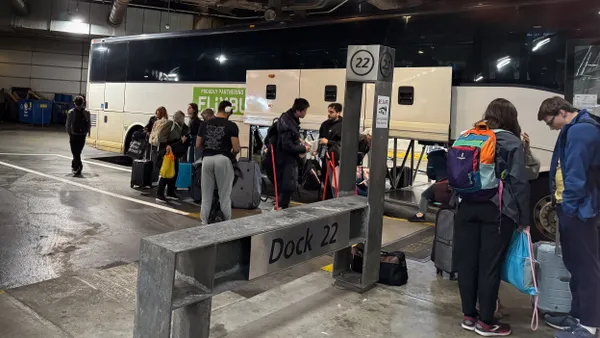UPDATE, June 4, 2020: The Ann Arbor, MI City Council unanimously adopted the city's $1 billion A2Zero climate action plan on Monday, having initially kicked a previous version back to staff for review in April.
Councilmembers did not adopt an initial version of the proposal over cost fears, but the new iteration of the plan did more to explain the up-front costs of actions vs. the long-term costs of not doing anything, said sustainability and innovations manager Missy Stults on a call with Smart Cities Dive. City staff also provided more clarity on how strategy and actions could evolve over the course of the 10-year living plan.
Stults cited the example of energy retrofits, which have been found by local utilities to yield $5 in savings for every dollar spent.
“Did that move anyone? I don't know,” Stults said. “But it's really important for changing the discourse to say, 'It's not just about an upfront cost.' We are not calculating the investment and cost of inaction in these equations, and it's time that we at least start openly and actively talking about that.”
The revised plan also made more clear that solutions can evolve. While the city's goals of using 100% clean energy or having a 50% reduction in vehicle miles traveled (VMT) may not change, the ways to get there might. Stults said a prioritization framework, under which any future actions can be evaluated for their impacts, will help introduce anything new in the future.
"Technology is changing, the climate is changing, society hopefully is changing, and so the idea that anything we wrote is going to be verbatim exactly what we do in 10 years, it's not real," Stults said. "But it is directional, and the strategies in that plan really are the guideposts."
Dive Brief:
- Ann Arbor, MI unveiled its $1 billion climate action plan last week with bold ambitions to reach carbon neutrality by 2030. Now, city leaders say they are exploring how its resiliency aspects can be accelerated considering the effects of the new coronavirus (COVID-19).
- The draft plan, titled "A2Zero," has six core strategies to achieving that goal: powering the electric grid with renewables; electrifying appliances and vehicles; improving buildings' energy efficiency; reducing miles traveled in personal vehicles; changing waste disposal and reuse methods; and enhancing resilience. The Ann Arbor City Council declared a local climate emergency last November and mandated the production of this plan.
- On a webinar Friday, Missy Stults, the city's sustainability and innovations manager, said the coronavirus outbreak has made officials think harder about how they can fast-track Ann Arbor to stronger resiliency, so it can deal with the next pandemic or extreme weather event. "This is a moment, at least for me, of deep reflection about what it means to create a resilient community, what it means to be a resilient household, what it means to be nested in a resilient neighborhood," Stults said.
Dive Insight:
A2Zero has an ambitious set of policy changes in a variety of areas, including land use and getting residents to be less reliant on personal vehicles with internal combustion engines. But the coronavirus and its impacts have given city leaders a new headache and led them to question all manner of things about urban life.
"For some of us, this is a moment where we're questioning why we do things the way that we do things, and we're questioning as we see systems break or falter, or as we see disparate health outcomes," Stults said of this period of pandemic response and mitigation.
Contained in the plan are some ambitious goals, including the desire to reduce personal vehicle miles traveled (VMT) in gas-powered cars. The city intends to use a variety of tools to help change people’s behavior, such as investing more in infrastructure like protected bike lanes, bus rapid transit (BRT) and ubiquitous sidewalks, while also providing incentives to help people transition to an electric vehicle (EV). There is also a big push to modernize building codes and retrofit existing buildings to make them more energy efficient — buildings and transportation are typically the two biggest emitters in cities.
Ann Arbor officials said they intend for implementation of the plan’s strategies to be funded through various sources, including philanthropy, state and federal dollars, public-private partnerships (P3s) and new funding mechanisms like green bonds. Stults said it was unclear if local taxes would also be raised to help pay.
A key part of this will be a relationship with the University of Michigan, whose campus is responsible for around one-third of the city’s emissions. The plan includes analysis on if the university participates fully or not in each strategy, and Stults said they are eager for a "much deeper collaboration" with the college and to "sit at the table together."
The plan is intended to be a living document, and comes after 80 meetings, three public surveys, two town halls and the distribution of 11,000 flyers to students up to eighth grade in Ann Arbor Public Schools. City leaders said they will continue working on strategies and new ways to achieve their goals.
"This isn't just a one-off where we just do this and then we just leave it alone," Galen Hardy, the city's sustainability and innovations engagement specialist, said during the webinar. "As the document grows, and it's a living document, there's going to be more engagement, because as it changes and evolves, we need to make sure that the populace is informed of the changes and the things that we're expecting from the citizens of Ann Arbor and letting them know that we're leading by example."
To keep up with all of our coverage on how the new coronavirus is impacting U.S. cities, visit our daily tracker.












